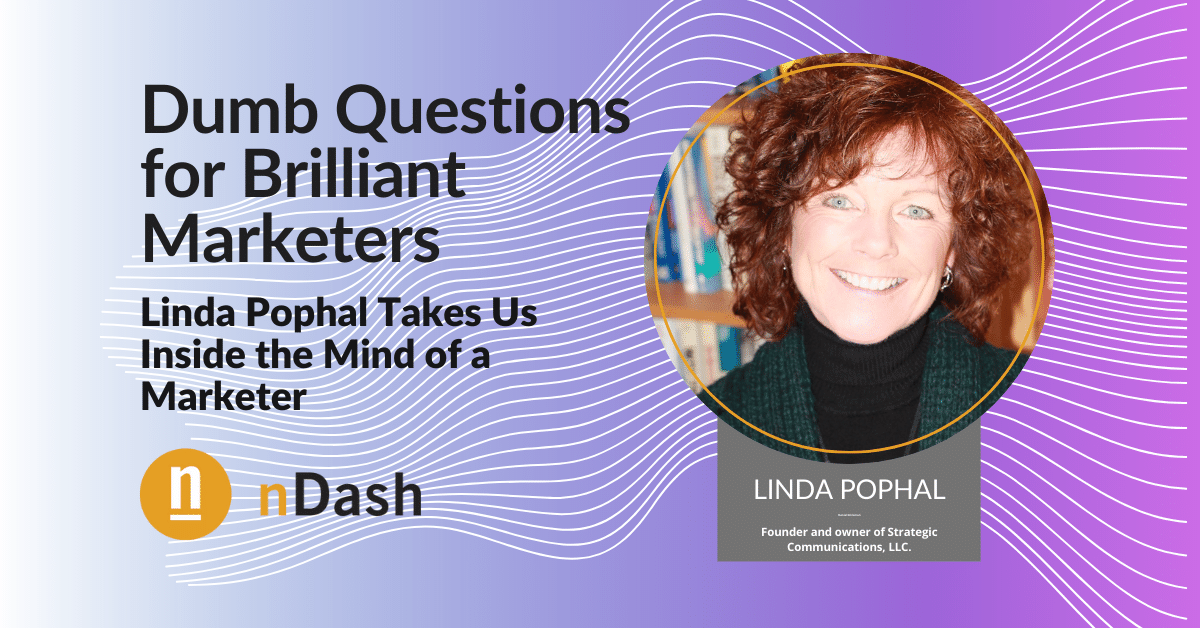We’re back with another marketer interview as part of our Inside the Mind of a Marketer series. This time, nDash’s Managing Editor, Jenn Greenleaf, talks to Strategic Communication’s founder and owner, Linda Pophal, about all things marketing.
Jenn: Can you give us some background on your role at Strategic Communications and your journey as a content marketer?
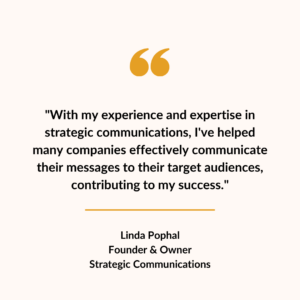
Linda: I’m Linda Pophal, and I founded Strategic Communications in 2008. Before starting my own business, I worked as a Director of Corporate Communications and Marketing in various industries, including education, energy, and healthcare. During this time, I also did a lot of freelancing, which gave me the idea to strike out independently. Although it wasn’t the best time to start a business, I took the leap and started my own company.
Starting my business wasn’t easy. When I left my full-time job, my major clients cut back significantly, making finding new clients and consistent work challenging. However, this time also allowed me to focus on social media, where I became an early adopter of platforms like LinkedIn and Twitter. This helped me stand out from my colleagues and former colleagues, who weren’t as familiar with these channels. As Google started rewarding original content and changing its algorithms, my business grew and remained consistent.
In recent years, my company has become increasingly busy, especially with the upheaval caused by the pandemic in the HR space. Many companies, particularly software service companies, are looking for HR-related content to help them stand out as authorities as they attempt to sell their services to organizations, which has kept me very busy. With my experience and expertise in strategic communications, I’ve helped many companies effectively communicate their messages to their target audiences, contributing to my success.
Jenn: Do you find that you have to outsource many of the content requests you receive as a marketer?
Linda: No, that doesn’t happen much. But my son assists me with certain topics. He’s an attorney with a full-time job, but he’s always willing to lend a hand, particularly when I’m grappling with complex subjects. I also have other contractors who assist with social media posts, research, and interviews. However, when creating the actual content, I handle most of that task myself.
Jenn: What do you believe are the most common mistakes marketers make within SEO/content marketing?
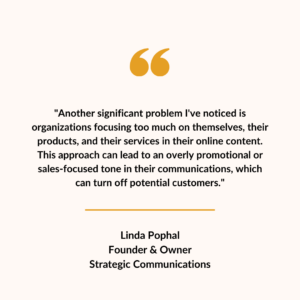
Linda: One of the most common issues I’ve observed is organizations starting and stopping their online activities. For example, they may have established a social media channel or a blog, but then they fail to post any new content for an extended period. This inconsistency can harm their online presence and hinder their ability to build a following.
Another significant problem I’ve noticed is organizations focusing too much on themselves, their products, and their services in their online content. This approach can lead to an overly promotional or sales-focused tone in their communications, which can turn off potential customers.
Also, some organizations seem hesitant to engage in conversations online, particularly regarding negative comments. This reluctance to respond to comments can be detrimental to their reputations, and it’s essential to know how to handle negative feedback appropriately.
Jenn: As a marketer, do you feel like email marketing is a missed opportunity?
Linda: I believe email marketing can be challenging for organizations to succeed in, especially in the B2B environment where I primarily work. While analytics platforms and tools are available to help organizations, the sheer number of people doing it and the firewalls set up within organizations can make it difficult to get into the target audience’s inbox. Even if an email does make it to the inbox, it may be marked as spam or ignored altogether, making it a missed opportunity.
Despite these challenges, there is still an opportunity for organizations that can execute email marketing effectively. However, in my experience, traditional direct mail marketing can be a more productive approach because it’s not as cluttered as email marketing. While direct mail marketing may be more expensive, it can be a worthwhile investment for organizations looking to reach their target audiences and make a lasting impression.
I think it’s important for organizations to consider email and direct mail marketing as potential strategies and determine which approach best suits their specific goals and target audience.
Jenn: Do you think marketers are holding back on some of these activities because they’re concerned about getting lost in all the noise?
Linda: I believe the issue might be a lack of understanding regarding what to do or how to do it. The challenging aspect of this particular task is that it appears easy, and indeed, it’s simple enough for people to attempt it themselves. However, they might not execute it well, which could lead to subpar results.
Consequently, I think many individuals miss out on opportunities because their experiences haven’t been positive, possibly due to not performing tasks the way they should have.
Jenn: How do you explain the difference between marketing and content strategies?
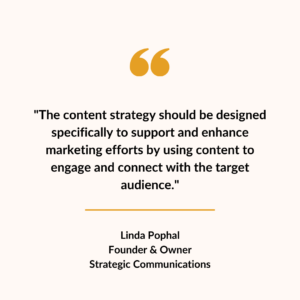
Linda: As I see it, marketing is a much broader concept than most people realize. It’s not just about promotional materials or social media presence, but it encompasses every aspect of a business geared towards appealing to a target audience. This includes the products and services offered, pricing strategies, and distribution channels, all tailored to cater to the needs and preferences of potential customers.
On the other hand, promotion is just one component of the overall marketing strategy. The content strategy should be designed specifically to support and enhance marketing efforts by using content to engage and connect with the target audience. This audience could include both prospects and existing customers, and the goal is to attract, inform, and retain them through valuable and relevant content.
Jenn: As a marketer, what do you see as the pros/cons of doing writing 100% in-house?
Linda: In my experience, there are clear benefits to keeping content creation in-house. When I worked in the internal communications and marketing departments, I found that our in-house teams deeply understood the company, its products, and its services. This was because they lived and breathed the organization daily, giving them an unparalleled knowledge of what’s important. Additionally, working with internal staff can sometimes be less expensive than hiring external resources.
However, there are also drawbacks to relying solely on internal teams. One major issue I’ve encountered is that internal communication and marketing departments are often extremely busy and pulled in many different directions. This can make it difficult for them to allocate time for strategic thinking and effective content creation. In these cases, seeking external support can provide valuable resources to supplement the internal team’s efforts.
Additionally, working with external contractors or agencies exposes the company to new tools, technologies, and creative ideas that might not be available within the company. While internal staff may attend conferences or read trade publications, it’s different from gaining hands-on experience with diverse clients and projects.
Jenn: You mention repurposing content – how do you advise your clients about how to prioritize those activities?
Linda: I think approaching it strategically is the best thing to do. At the outset, set up a database or system; there are tools to help. That way, you can keep an ongoing inventory or catalog of your content and when it was created. Look at what it covered, the keywords, and the links. Then, set date tags for when you want to review those pieces of content or update them. I think that that’s probably what would be the ultimate.
I don’t see many organizations doing that, even some very big ones, which surprises me. One of the things that I’ve seen with some clients, especially large organizations, is they create a ton of content. But it gets buried and lost quickly, and they’re just constantly creating new pieces without appreciating the value of that existing content. They could also leverage their analytics to monitor what content is appealing and appeals to different audiences.
Jenn: Has content marketing, or digital marketing in general, gotten easier or harder over the past several years? How?
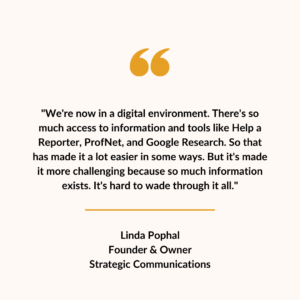
Linda: Both easier and harder. It’s easier because there’s so much access to information. I remember the days when I first started writing, and I had to look for sources at the library. And, I had to find people, and then you had to find their telephone numbers and call them, and very often, they wouldn’t be interested in talking with you. So it was a struggle.
We’re now in a digital environment. There’s so much access to information and tools like Help a Reporter, ProfNet, and Google Research. So that has made it a lot easier in some ways. But it’s made it more challenging because so much information exists. It’s hard to wade through it all.
And it can also be hard to tell what’s credible and what’s not. And which sources are credible and which may not be, and it’s easy enough for anybody to put up a website these days. So, we can be easily fooled by sources that really aren’t reputable, or increasingly, and I haven’t run into this myself, but I’ve read that some are deep fakes. They aren’t even real people, which is frightening, too.
So that’s made it more challenging, and also, with the many different options out there, it’s challenging with all the different channels you could be on. Which ones should you be on? How do you find the resources to use them effectively? I think all of that has made it harder. So it’s kind of a mixed bag, I believe.
Jenn: As a marketer, do you feel like the rise of AI will complicate finding reputable resources?
Linda: I definitely think so. At first, I experimented with ChatGPT and thought it was really cool. However, the more I use it, the less impressed I become. One issue I discovered is that its knowledge only goes up until 2021, which seems absurd to me when I can Google something and find information from yesterday. This limitation is certainly challenging.
Additionally, I’m working on an article about ChatGPT because I’m curious about its potential risks in terms of plagiarism. While some claim it isn’t a problem because all queries are unique, I’m not so sure. I’m also concerned about where the AI sources its information from. On the other hand, I’ve found ChatGPT useful for generating ideas, brainstorming, and creating outlines to delve deeper into topics.
I haven’t done this yet, but I plan to see how AI tools might help me update my older posts with new information or organizational structure. I believe it’ll be helpful and become part of the content marketing process. However, as a content creator, I don’t see it replacing us anytime soon. It may gain that capability someday, but I believe it hasn’t quite reached that level.
Jenn: What role does original research play in content marketing? Why aren’t most brands doing it?
Linda: I believe the main issue is that people are incredibly busy, not just those in the marketing or communication departments but also the subject matter experts. I’ve experienced this first-hand with a large organization I work with. It astounds me how long it takes for content to move through the system, sometimes taking months. A significant part of this delay is due to the limited availability of subject matter experts who are often preoccupied with their own work.
Another issue I’ve observed is that people within organizations sometimes overlook simple solutions, such as conducting a quick Google search for information. In one large organization I dealt with, they didn’t even know who their internal contact person was, and I had to find it online myself. It’s baffling that they didn’t have an internal directory. I think there’s a real need for someone to focus on developing efficient processes, workflows, and strategies. Ultimately, I believe people are stretched thin and pulled in various directions, making it difficult to manage their tasks effectively.
Jenn: Do you think some of it might be that marketers feel a little intimidated about figuring out which questions to ask that would provide the most value?
Linda: I’m not entirely sure, but I think some subject matter experts I’ve interacted with are truly exceptional. They possess extensive knowledge in their fields, and many have high-level degrees, conduct their own research, or work as educators within the organization. However, I sometimes feel that they might be slightly intimidated or hesitant when dealing with customers, especially when working on case studies or seeking customer input for a particular project.
Their reluctance might stem from concerns about using customers’ names, titles, or businesses and how to handle that information. The involvement of legal or risk management departments can further complicate the process, causing delays or additional challenges. As a result, some experts may choose to avoid these situations altogether, as they’ve come to realize how difficult they can be.
Jenn: You mentioned in your notes that you believe PR is one of the most underutilized forms of marketing. Do you think that might be because there’s such a big approval process before getting content out there?
Linda: Yeah, that’s a good point. I hadn’t thought about that. There could certainly be challenges in public relations due to the need for timeliness. To capture the attention of the media, the information must be newsworthy. We might not get the desired coverage if we can’t deliver that quickly. I believe this could be a significant factor.
It’s similar to when I create content for certain projects, and I feel frustrated because the information is no longer new by the time it’s finally published. For example, others may have already covered the topic, leaving us lagging behind. So, this might indeed be a major aspect of the problem.
Jenn: Do you feel like maybe some brands don’t fully understand how PR works?
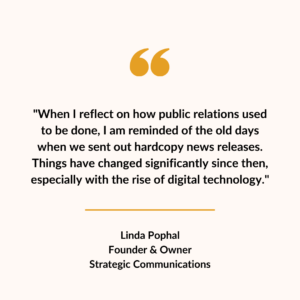
Linda: That’s possible. I think that’s all of us these days because it’s changed so much. When I reflect on how public relations used to be done, I am reminded of the old days when we sent out hardcopy news releases. Things have changed significantly since then, especially with the rise of digital technology. Teaching PR classes at the university has allowed me to compare and contrast the old and new methods with my students. The differences are striking, and it can be difficult for people to understand how the process works now.
As we discussed earlier, the credibility of sources is a major issue. Sometimes, very credible sources are out there, but they lack a strong online presence. As a result, they may be overlooked even though they are excellent. This disconnect occurs because they aren’t active in the digital world.
Moreover, the media landscape has evolved significantly over the years. Finding a match between the messages organizations want to disseminate and the ones media outlets want to publish can be challenging. The current political and social environment also plays a role for both large and small organizations. Many hesitate to engage in controversial conversations or associate their brands with certain issues. This hesitance might be causing them to step back from media engagement as well.
Jenn: Marketing to marketers is ______? (fill in the blank)
Linda: Marketing to marketers is a good place to focus. As a marketer, I have discovered that I can build a strong prospect base with other marketers. This realization initially surprised me, as I assumed larger organizations would have the necessary in-house resources to handle their marketing needs. However, I’ve come to understand that these professionals are often quite busy and stretched in multiple directions.
Due to budget constraints, many organizations find it easier to secure approval for hiring contractors rather than full-time employees, especially for project-based work. This opens up opportunities for people like me to offer our expertise and support to these busy marketers.
About Linda Pophal:
 Linda Pophal, the creative mastermind behind Strategic Communications, LLC, boasts an impressive skillset in marketing and communication strategy. As a specialist in HR, employee relations, strategic planning, B2B content marketing, PR/media relations, and social media, she has carved a niche for herself in the industry. Drawing from her diverse experiences as a freelance business journalist, advertising wordsmith, and corporate communication expert, Linda has honed her ability to craft compelling, tailor-made content that captivates, educates, and connects with audiences.
Linda Pophal, the creative mastermind behind Strategic Communications, LLC, boasts an impressive skillset in marketing and communication strategy. As a specialist in HR, employee relations, strategic planning, B2B content marketing, PR/media relations, and social media, she has carved a niche for herself in the industry. Drawing from her diverse experiences as a freelance business journalist, advertising wordsmith, and corporate communication expert, Linda has honed her ability to craft compelling, tailor-made content that captivates, educates, and connects with audiences.
Linda’s professional prowess receives recognition from both the American Marketing Association and the Society for Human Resource Management through her accreditations. Moreover, she is a sought-after digital marketing expert at the State of Wisconsin’s Center for Business Intelligence, where she continues making her mark on business communication.
